-
Discover new ways to elevate your game with the updated DGCourseReview app!
It's entirely free and enhanced with features shaped by user feedback to ensure your best experience on the course. (App Store or Google Play)
You are using an out of date browser. It may not display this or other websites correctly.
You should upgrade or use an alternative browser.
You should upgrade or use an alternative browser.
Rocking the Hips
- Thread starter drk_evns
- Start date
Yo this is actually a brilliant drill idea. Try throwing from a squatty position. Like hands even with your knees. Get squatted and throw baby. It's almost impossible to spin and throw like this. It's almost impossible to tilt the wrong way. All kinds of great feedback from this position.
What are your thoughts on the interactions that I described between the lead femur and the hips? To summarize: Once the brace is established, the primary contributor to rotational energy in the throw is the horizontal force that the lead femur applies on the lead hip socket, acting in a direction opposite of the linear momentum of the body. And in order to create space for this rotation to happen, the lead femur needs to have swung wide relative to the hips before the brace was established.
Is this sensation a good one to be feeling in the squatty drill, and is that biomechanical action a good one to be trying to transfer to a real throw (when the hip hinge is not as exaggerated)?
Brychanus
* Ace Member *
Yo this is actually a brilliant drill idea. Try throwing from a squatty position. Like hands even with your knees. Get squatted and throw baby. It's almost impossible to spin and throw like this. It's almost impossible to tilt the wrong way. All kinds of great feedback from this position.
This is like disc golf's version of the speed/ sprint drill "Squatty Run", which is a response to the conventional running wisdom of "get tall":
Check it out: https://www.stack.com/a/the-squatty-run-the-weird-drill-that-changes-how-you-sprint-for-the-better/
In the gym this AM I just did a bunch of lateral squatty "duck walks" with Elephant Walk-like tilt back and forth (think backswing + downswing as you walk) and it was a great little exercise. I could get a very natural recruitment of the leg and core sequence and a good functional workout. Can also swing the arm back and forth like the Elephant Walk while you do it.
You need to be careful with those as a "DG Drill" because you still need to end the last step by getting the full weight shift targetward. The weight needs to come in fully in the plant/penetrating through and targetward rather than remaining with the CoG too trapped between the feet in the squat/shuffle. So on the last step you can carry all the way through like an Elephant Walk toward the target to get that effect. Seemed to help the two-step form I'm working on.
What are your thoughts on the interactions that I described between the lead femur and the hips? To summarize: Once the brace is established, the primary contributor to rotational energy in the throw is the horizontal force that the lead femur applies on the lead hip socket, acting in a direction opposite of the linear momentum of the body. And in order to create space for this rotation to happen, the lead femur needs to have swung wide relative to the hips before the brace was established.
Sorry, man, I had a tough time trying to understand how to swing my femur out wide of the hips as you suggested. Not saying it's wrong, but that I wasn't able to get it. For me, it induced external rotation in the femur before I planted, which limited my ability to resist/ put on the brakes in the plant. I could have been performing the motion not as you intended, though. And don't let me "not getting it" stop you from continuing to experiment and toy around with the idea. That's the best way to learn.
My advice might be to try and focus on some other body parts in addition to the femur, like the shin and the ankle and the foot. How do those contribute to the femur's ability to push into the hip?
Also keep in mind that the leg's position varies as it "swings" into the plant. Let's use SW22's kick the can drill as an example, but you won't even have to leave your office chair. Pick your plant foot/leg off the ground and swing it toward your other leg so that you can see the inward side of your shoe w/ the sole perpendicular to the floor. Then, swing it the other way away from your body so that the outside part of your shoe is now facing up. Your femur externally rotated and then internally rotated as you swung your lower leg. Compare this to the feeling of the swing leg femur in your walking gait. Should be the same.
My hang up when trying your drill was that there wasn't a similar transition/ rotation of the femur for me in the swing phase before planting.
I could get a very natural recruitment of the leg and core sequence and a good functional workout.
I think that might be the biggest benefit.
Cool, man. Thanks for trying it out. I did a few dozen throws like this into a net in my yard yesterday, and boy am I feeling it today. Good advice on trying to avoid getting trapped in between your feet and committing to the weight shift. I can easily see how that would happen, but I had the opposite problem: usually, my throw ends more like KJ Nybo or Markus Kallstrom, totally braked. My front foot heel even pops off the ground sometimes. (Not saying that these are good things, or that I am actually bracing effectivley in the same manner as Nybo or Kallstrom.) Anyways, in the squatty throws, I had to take a step forward past the brace with my drive leg. Weird!
I don't know what the purpose/value of this exercise is. For me, it makes it harder to make some common mistakes: spinning shift into the plant, striding too staggered/ leftward into the plant. Haven't fully experimented yet, but I wager that the squatty throw also makes it pretty darn hard to pull your shot to the right (for RHBH) by mistake.
Brychanus
* Ace Member *
I think that might be the biggest benefit.
Cool, man. Thanks for trying it out. I did a few dozen throws like this into a net in my yard yesterday, and boy am I feeling it today. Good advice on trying to avoid getting trapped in between your feet and committing to the weight shift. I can easily see how that would happen, but I had the opposite problem: usually, my throw ends more like KJ Nybo or Markus Kallstrom, totally braked. My front foot heel even pops off the ground sometimes. (Not saying that these are good things, or that I am actually bracing effectivley in the same manner as Nybo or Kallstrom.) Anyways, in the squatty throws, I had to take a step forward past the brace with my drive leg. Weird!
Very nice -
You may be describing the water SW22 has led me to just now - there is a fine line in "ideal" bracing and some degree of carry forward is efficient for achieving a maximal hit. It's really obvious in Wiggins' max distance form - this incredible lead with his CoG ripping the disc forward, and carrying forward after the plant over the ball of the foot.
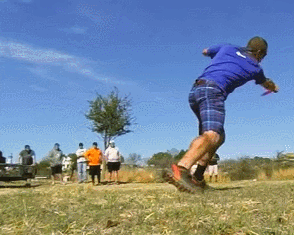
and SW22's side view with ground pressure readings:
I realized that after the sequence and posture has gotten much better, the move feels more and more like tackling/"spearing" a target with a low shoulder:
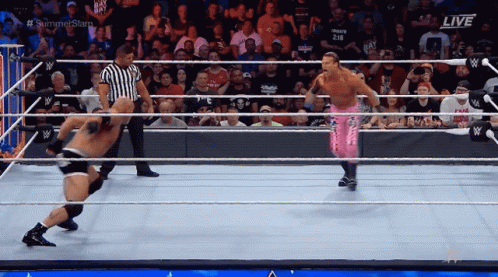
and I feel like I'm letting the disc pump carry me forward like Mjolnir ripping Thor off the ground:
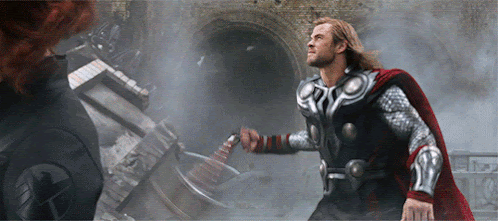
loading up to strike briefly against my drive leg while the CoG moves forward
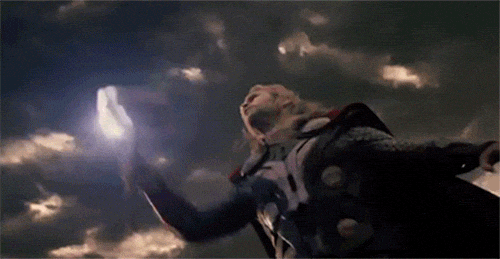
and then planting and smashing the Hulk:

but with a backhand. Wow, it looks like Thor would have a mean forehand too.
What does any of this shameless excuse to post Thor gifs have to do with rocking the hips? Well, if the feet and CoG aren't in the right spot, all of the kinetic sequencing in the world won't get that ideal force from the ground and you can't knock out the Hulk, and you're probably going to hurt yourself if you're not careful. Learn to be like Thor attacking low and fast like Goldberg's spear.
I was thinking about the Kallstroms and Gibsons and Nybos more and it seems like they get a very significant brake+torque force out of that front leg in slightly different ways. I bet it's a big source of power but I worry about how hard it might be on that lead hip. I think Wiggins is definitely carrying a scary amount of force into that plant, but he has found a way to put a massive hit on the disc and diffuse a lot the excess forward and "vertically". Similar phenomenon in SW22's vid (hey, he's pretty good at this!).
I don't know what the purpose/value of this exercise is. For me, it makes it harder to make some common mistakes: spinning shift into the plant, striding too staggered/ leftward into the plant. Haven't fully experimented yet, but I wager that the squatty throw also makes it pretty darn hard to pull your shot to the right (for RHBH) by mistake.
I'm becoming a big fan of functional training exercises that build the muscle groups in sequences similar to those used in the throw. It's more fun than my stale workouts anyway.
It seems important to build up some body resilience at a certain point. As a case in point, in the last few weeks there was a big increase in the demands on my core/slings - all those important diagonal muscles I never exercised very well before. I've been taking time off to let stuff heal, but tried about 10 shots with my emerging "freewheeling" form to keep cleaning my weight transfer issues up.
On the better swings leading with my CoG ahead of the drive step, everything felt and looked smoother than ever, but I was surprised to feel strong & fast muscle contractions coming up through my body. In a good way, I think - fast "peak" contractions running smoothly up the chain. It felt distinctly like I was swinging a brick with all my weight and gravity and trying to hold on to it for dear life. I was not trying to throw hard but the disc came out with surprising violence. It was "effortless," but definitely the most "athletic" I've felt in a long time. The deceleration force up through the arm was serious and surprising so I stopped, remembering that I'm supposed to be taking it easy. That's even harder now that I've felt the sensation lol. But that separate functional training probably helps develop muscle control, strength, and injury resistance in the long run.
On that note I'm probably going to get a vid up soon about expectations/physical adaptation while I'm throwing less because I drastically underestimated what a powerful throwing move felt like and the demands it puts on the body. Will probably also be waddling around like a duck gleefully pretty often now.
Last edited:
Brychanus
* Ace Member *
I aimed to integrate lessons from Rocking the Hips under the umbrella of Rocking the Body here. Hopefully there's nothing conceptually surprising here. I wanted to do it before my springs were all permanently tightened so people can see what they look like when they're loose.
Special shoutout to SocraDeez and Sidewinder22 for helping me break through on this & ongoing tweaks.
Always recommend people go back and watch Figure 8 in particular if it's been a while.
Special shoutout to SocraDeez and Sidewinder22 for helping me break through on this & ongoing tweaks.
Always recommend people go back and watch Figure 8 in particular if it's been a while.
Last edited:
The core powers the swing.
Do you think it's more the glutes/lower legs that "power" it (aided by the extra mass/load of core/torso sitting atop them)? In this view, the core more stabilizes + transfers the power while also adding power from that stretch-to-contraction cycle.
I would say the core powering the throw would be MORE consistent with "Engage or Fire the Hips", right?
3. Should I be clenching the heck out of my abs/core muscles after my left foot hits the ground (2nd to last step), so that the backswing builds tension in my "rotational spring"? Up to this point I've been pretty loose in the core, in order to facilitate more coiling of my shoulders relative to my hips, and in order to prevent any muscle tension from subconsciously propagating out to my arm. But it sounds like this looseness is stopping me from properly storing tension in my "spring"?
3. Please don't "clench." It should be a consequence of posture/balance/sequencing/weight shift heading into the plant. Your backswing is braced against the drive (rear) leg & your swing is braced against the plant (front) leg. If you do that correctly it will load/unload the core/slings. See also "myotatic reflex". If you muscle up/rush things, you can't naturally stretch muscles with the right mechanics, and you lose a ton of power in the throw.
I don't think that "don't clench" or actively contract is always true. It depends, ya know. There's lots of evidence that active core contraction can increase appendage velocity by adding juice to that stretch-contraction action. Of coure, you got to time it right. And it's most certainly not "after my left foot hits the ground (2nd to last step), so that the backswing builds tension in my 'rotational spring'?"
The core might be the easiest muscle group for which you can accelerate contraction + time it properly after a stretch because it houses your lungs - i.e. the tennis grunt.
It's definitely not necessary to actively accelerate core contraction during the disc golf swing, but I also think it's far from wrong. It's hard to say how much extra velocity we're considering here - and I don't think it's a ton - but I'd wager that it's more common than not in high level players.
Brychanus
* Ace Member *
Do you think it's more the glutes/lower legs that "power" it (aided by the extra mass/load of core/torso sitting atop them)? In this view, the core more stabilizes + transfers the power while also adding power from that stretch-to-contraction cycle.
I would say the core powering the throw would be MORE consistent with "Engage or Fire the Hips", right?
Letting SW22 hit that one, but this makes sense at face value to me.
I don't think that "don't clench" or actively contract is always true. It depends, ya know. There's lots of evidence that active core contraction can increase appendage velocity by adding juice to that stretch-contraction action. Of coure, you got to time it right. And it's most certainly not "after my left foot hits the ground (2nd to last step), so that the backswing builds tension in my 'rotational spring'?"
The core might be the easiest muscle group for which you can accelerate contraction + time it properly after a stretch because it houses your lungs - i.e. the tennis grunt.
It's definitely not necessary to actively accelerate core contraction during the disc golf swing, but I also think it's far from wrong. It's hard to say how much extra velocity we're considering here - and I don't think it's a ton - but I'd wager that it's more common than not in high level players.
On long drives there's definitely a brief period after the peak of the reachback entering the hit where the big guns look like they're putting a momentary high-effort contraction in.
So I'm curious about this and the best learning practices.
Are we talking about wholesale contraction of the abdominals & muscles in the spinal column (is that the same as the tennis grunt?), or oblique slings, or something else?
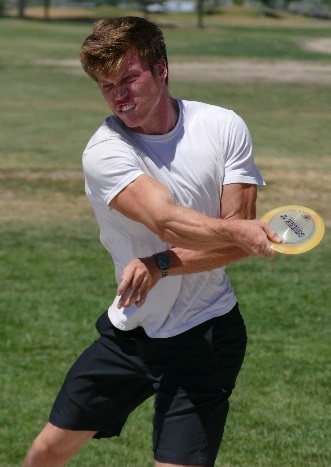
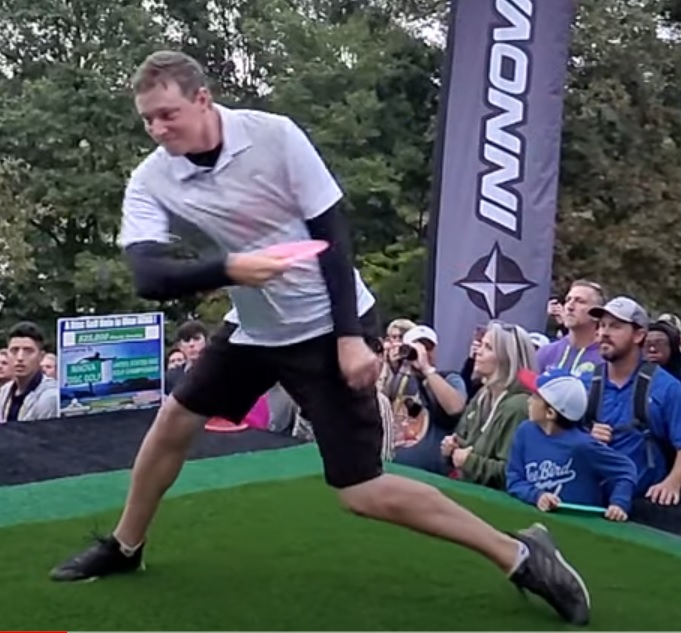
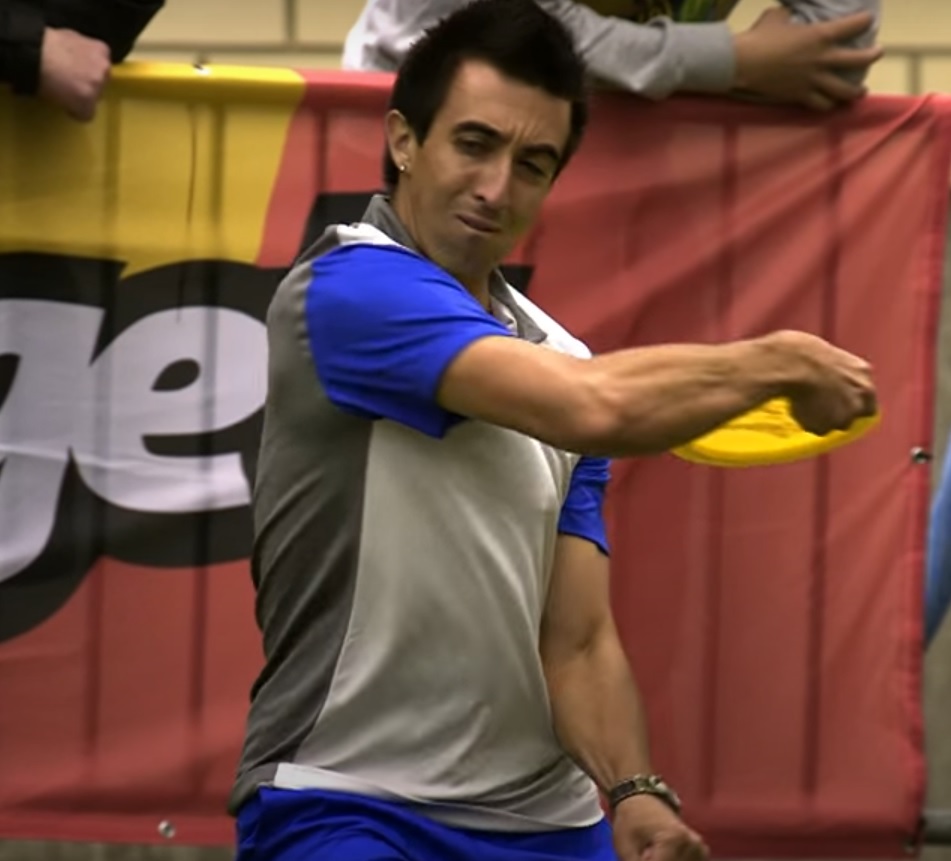
seedlings
* Ace Member *
This Matty-O shot is outrageous. I suspect his facial expression and muscles weren't bulging quite like Ezra or Paul above. His hips look muted compared to many other pros. I'm in awe and perplexed!
Nick Pacific
Eagle Member
- Joined
- Jan 18, 2013
- Messages
- 992
I aimed to integrate lessons from Rocking the Hips under the umbrella of Rocking the Body here. Hopefully there's nothing conceptually surprising here. I wanted to do it before my springs were all permanently tightened so people can see what they look like when they're loose.
Special shoutout to SocraDeez and Sidewinder22 for helping me break through on this & ongoing tweaks.
Always recommend people go back and watch Figure 8 in particular if it's been a while.
Thank you for the reminder to keep that back leg behind me trailing and not allow it to swing out too early and spin me around which contributes to rounding!!! I learned that what seems like months ago, incorporated it with really good success but somehow forgot it and I'm sure I've gone back to old bad habits of swinging that back leg around too fast and spinning out. Will be the focus of field work tomorrow!
On long drives there's definitely a brief period after the peak of the reachback entering the hit where the big guns look like they're putting a momentary high-effort contraction in.
Yeah, on the timing, it would need to be after the weight shift. I wouldn't characterize it as "high-effort" - you're more adding extra juice to an existing system vs. creating something anew. So it's relatively efficient in that regard.
So I'm curious about this and the best learning practices.
Never practiced it, so you'll have to experiment and report back. Please, good people, as the instigator of this topic, I beg you to not inundate this good thread with questions about when to grunt and what to grunt and, most abhorrently, "Should YOU grunt?"
Off the top of my head, Nikko is a grunter.
One more thing: this isn't some huge super secret that's been hoarded away from y'all. Nor is it something that is meant as advice that WILL improve YOUR throw. Most of you are probably already doing this to some degree.
An example: While toying around with this idea and watching NFL football today (we are engaging in living room theory here), I discovered that I do rapidly exhale air from my lungs when I kick a soccer ball. In the thousands upon thousands of times that I have kicked a soccer ball, when and how did I decide to start doing this? Did the rapid expulsion of air from my lungs accelerate the contraction of my core? Or did the contraction of my core accelerate the rate of air leaving my lungs? To quote Wallace Stevens here: "In ghostlier demarcations, keener sounds."
Are we talking about wholesale contraction of the abdominals & muscles in the spinal column (is that the same as the tennis grunt?), or oblique slings, or something else?
Try to grunt. Or try to hiss*. Whatever just happened in your core is what we're talking about here. Now try to actively contract some other specific muscles or muscle groups in your body. Pick a few. Play with the discussion.
Compare notes. What felt quickest?
*
You don't have to actually make a noise to produce the effect. For whatever reason - I say "whatever", but the reasons are probably endlessly interesting and complex - it seems easiest to learn by actually making a noise. Maybe even a gasp! (After gasping several times and frankly worrying my dog, I must revise that to read: Maybe even a sigh!).
Again, this is living room theory from someone who has not actively tested the topic of discussion to see how it might shine within the disc golf swing constellation. The point remains: "don't actively contract" is really good advice that I agree with, but it is not always the rule of the land, especially in regard to the "core". Willfully inducing the contraction of the core is a bit of a special case because (a) we're accelerating an already rolling stone, (b) it's easy-ish to time, and, most importantly, (c) we're playing a bit of a trick by using the lungs to induce the effect. But it's a very clever trick: we're much practiced at exhaling air from the lungs, and the neural networks that transmit our desire to do so developed long before any of us were called upon to take that beautiful, and tragic, first breath.
seedlings
* Ace Member *
I wonder if the momentary effort is to keep the shoulder-arm angle from collapsing.
Moderately slow and short walk up. Moderate body movement. Was this really 500'? Rick seems like he puts in the least effort for most return on the throw. Efficient. Mind blown. Seems like literally anyone should throw 500'.
Move slow. Move fast. Big boy power lives beneath the grass. Check out Rick's rear leg load here. His front foot is still off the ground at this point. Absolutely disgusting.
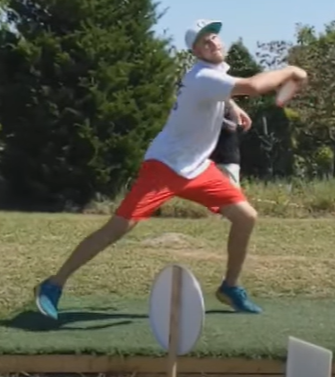
This Matty-O shot is outrageous. I suspect his facial expression and muscles weren't bulging quite like Ezra or Paul above. His hips look muted compared to many other pros. I'm in awe and perplexed!
Sick shot. It's hard to see the hip power in the uber-prevalent, behind-the-tee-pad camera position like:
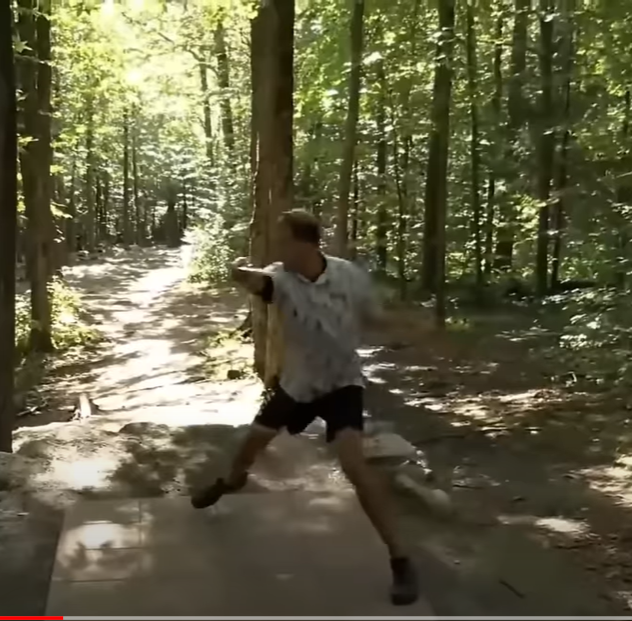
But ain't nothing muted about that rear leg load from the side:
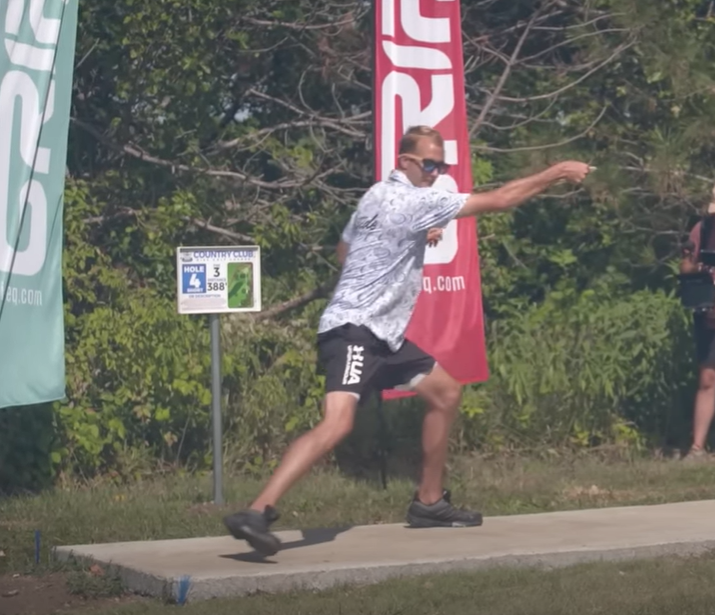
Compare with:
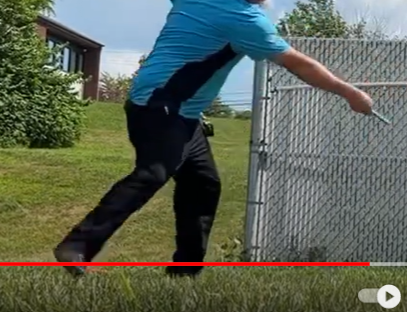
seedlings
* Ace Member *
Sick shot. It's hard to see the hip power in the uber-prevalent, behind-the-tee-pad camera position like:

But ain't nothing muted about that rear leg load from the side:

Compare with:

Yep. I'm working on it!
- Joined
- Nov 2, 2008
- Messages
- 22,055
Do you think it's more the glutes/lower legs that "power" it (aided by the extra mass/load of core/torso sitting atop them)? In this view, the core more stabilizes + transfers the power while also adding power from that stretch-to-contraction cycle.
I would say the core powering the throw would be MORE consistent with "Engage or Fire the Hips", right?
I consider the glutes to be part of the core as do many professionals. The legs are an extension of the core that can stabilize(brake) or amplify(gas pedal) it, but the legs are not the actual power source or engine. The core coils and unwinds relaxed(I didn't say "fire the core"), it does not stabilize while in athletic motion. Context matters.
drk_evns
Eagle Member
Recently I've been focusing on the "sit" into the power pocket. Going all the way back to the original post, it would be the process to get from image #2 to #3.
It feels just like the doorframe drill position to me. Like your hips/core are pushing towards the target leveraged on that back leg. The upper body uncoils really fast and sort of effortlessly towards the target after that.
In my throw, this is the difference between a 380-420 foot range and the 450-500 foot range.
I've also started thinking about my x-step more like AB with a really quick (almost aerial) shuffle. Helps keep me from a big x-step and an early backswing.
It feels just like the doorframe drill position to me. Like your hips/core are pushing towards the target leveraged on that back leg. The upper body uncoils really fast and sort of effortlessly towards the target after that.
In my throw, this is the difference between a 380-420 foot range and the 450-500 foot range.
I've also started thinking about my x-step more like AB with a really quick (almost aerial) shuffle. Helps keep me from a big x-step and an early backswing.
I've been working on incorporating rocking the hips into my throw. I always had a problem with planting too long and slightly open. I never realized that rocking the hips "DOWN" is the correct way to stride. It naturally shortens your stride and plants closed. I also never realized that the rock down is how you turn back, which prevents (or reduces at least) early reachback.
One big thing that isnt mentioned that may be obvious to most but not to stubborn fools like me is that you do NOT have to "lock out" your hips (maximum rock) during each phase the rock!! Do not do this! It will make the rock very slow and clunky
One big thing that isnt mentioned that may be obvious to most but not to stubborn fools like me is that you do NOT have to "lock out" your hips (maximum rock) during each phase the rock!! Do not do this! It will make the rock very slow and clunky
I've had some "good" rounds recently (score-wise) really focusing on that door frame coming out of a small overlap x-step. But I qualify that, as my backswing is too early and I take too long a final step, so I'm having to exaggerate/force a delay in the forward swing as I wait for the plant and the hips to ride forward into that final rock. Or not, and everything spins out early.Recently I've been focusing on the "sit" into the power pocket. Going all the way back to the original post, it would be the process to get from image #2 to #3.
It feels just like the doorframe drill position to me. Like your hips/core are pushing towards the target leveraged on that back leg. The upper body uncoils really fast and sort of effortlessly towards the target after that.
In my throw, this is the difference between a 380-420 foot range and the 450-500 foot range.
I've also started thinking about my x-step more like AB with a really quick (almost aerial) shuffle. Helps keep me from a big x-step and an early backswing.
I definitely can feel that "bow and arrow" (per SW22) release doing this, and the results are there (410ish feet for me). But I know it's not right, and I put more strain on my back when I unwind. I've on rare occasion felt that "effortless" throw you're describing, but man, for me the timing is really hard.
The good news is that I've finally felt many of the essential components, but now I have to synthesize them. Such a strangely addicting thing, chasing the correct throw.
Brychanus
* Ace Member *
I will have a more cogent update soon because my understanding of the rock and specifically the drive leg was upended yet again. IMO it is one of the most difficult and misunderstood actions and I cannot tell you how many ways I've done it wrong, but there are apparently many.
The only way I have made practical progress on this in my own form when my feet are moving is finding a familiar problem and yoking the X-step to it. I don't think this will help everyone, but once I found an action similar to other moves my body already knew well it started to improve quickly. It only started to work because of all the other mechanics I've gained so far - you'll see all the seabas22 lessons in how I move here in one form or another. I was almost mad at how easy it seemed once I did this but happy it worked:
Getting the drive leg action right is so important to the overall form, and it's easier to do the better the overall form is - one of those frustrating deep problems. Once I yoked it to the bag strike problem it started to get through to my brain and body.
The only way I have made practical progress on this in my own form when my feet are moving is finding a familiar problem and yoking the X-step to it. I don't think this will help everyone, but once I found an action similar to other moves my body already knew well it started to improve quickly. It only started to work because of all the other mechanics I've gained so far - you'll see all the seabas22 lessons in how I move here in one form or another. I was almost mad at how easy it seemed once I did this but happy it worked:
Getting the drive leg action right is so important to the overall form, and it's easier to do the better the overall form is - one of those frustrating deep problems. Once I yoked it to the bag strike problem it started to get through to my brain and body.
Similar threads
- Replies
- 8
- Views
- 828
- Replies
- 100
- Views
- 6K
- Replies
- 2
- Views
- 887